Performance Analysis of RIS Assisted NOMA Networks over Rician Fading Channels
Xianli Gong,Chongwen Huang,Xinwei Yue,Zhaohui Yang and Feng Liu,*
1School of Electronic and Information Engineering,Beihang University,Beijing,100191,China
2College of Information Science and Electronic Engineering,Zhejiang University,Hangzhou,310027,China
3International Joint Innovation Center,Zhejiang University,Haining,314400,China
4Zhejiang Provincial Key Laboratory of Information Processing,Communication and Networking(IPCAN),Hangzhou,310027,China
5School of Information and Communication Engineering,Beijing Information Science and Technology University,Beijing,100101,China
6Zhejiang Laboratory,Hangzhou,311121,China
ABSTRACT In this paper,we consider a downlink non-orthogonal multiple access(NOMA)network assisted by two reconfigurable intelligent surfaces(RISs)over Rician fading channels,in which each user communicates with the base station by the virtue of a RIS to enhance the reliability of the received signal.To evaluate the system performance of our proposed RIS-NOMA network,we first derive the exact and asymptotic expressions for the outage probability and ergodic rate of two users.Then,we derive the exact and asymptotic upper bound expressions for the ergodic rate of the nearby user.Based on asymptotic analytical results,the diversity orders for the outage probability and the high signal-to-noise ratio (SNR) slopes for the ergodic rate of the two users are obtained in the high SNR regime.Moreover,we derive the system throughputs of the proposed RIS-NOMA network in delay-limited and delay-tolerant transmission modes.Numerical results confirm our analysis and demonstrate that:1)The outage probability and ergodic rate of RIS-NOMA networks are superior to that of RIS-assisted orthogonal multiple access(OMA)networks;2)The RIS-NOMA networks have ability to achieve a larger system throughput compared to RIS-OMA networks;and 3)The system performance of RIS-NOMA networks can be significantly improved as the number of reflecting elements and Rician factor increases.
KEYWORDS Non-orthogonal multiple access;reconfigurable intelligent surface;outage probability;ergodic rate
1 Introduction
As a promising multiple access technology in the next generation wireless communication network,non-orthogonal multiple access(NOMA)has the ability to tremendously enhance the spectral and energy efficiency[1,2].The distinguishing feature of NOMA is that multiple users with different quality-of-service requirements are served by exploiting the superposition coding scheme in the same time/frequency/code resource block[3-5].In[6,7],the authors have proved that the outage probability and ergodic rate of NOMA can be better than that of conventional orthogonal multiple access(OMA).Zhu et al.[8] have proposed an optimal power allocation scheme learned by adopting the deep deterministic policy gradient algorithm in multiple-input multiple-output NOMA vehicular edge computing.
Recently, reconfigurable intelligent surface (RIS) has been regarded as a promising technology for the next generation wireless communication,which can improve the spectral and energy efficiency of future wireless communication networks in a cost-effective way [9-11].Specifically, RIS is a lowcost planar array composed of a large number of reconfigurable passive elements, in which the amplitude and phase of the incident signal for each element can be changed independently[12,13].By adjusting the amplitude and phase coefficients of RIS elements through programmable controller,the electromagnetic signal can be reconfigured to significantly enhance the signal quality and the coverage of wireless communication[14].Compared with the conventional relaying technology,the advantage of RIS is that the passive reflection does not consume energy and it does not generate self-interference in full duplex (FD) mode [15].The RIS-empowered multiuser uplink communication system has been investigated in [16], in which a channel estimation framework based on the parallel factor decomposition has been proposed to unfold the resulting cascaded channel model.In[17],the authors have studied the downlink wireless communication system, in which the transmit beamforming and the RIS have been jointly optimized to maximize the energy efficiency of the system.A new joint design of the transmit beamforming and the phase shifting of the RIS has been proposed in[18],in which the sum rate of the multiuser system has been maximized by using deep reinforcement learning(DRL).In[19],the multiuser communication system assisted by RIS has been considered,in which the power allocation and the phase shifting of the RIS have been jointly optimized to minimize the sum transmit power.Considering RIS-empowered terahertz band communications,a DRL-based hybrid beamforming scheme has been proposed in[20]to improve the communication coverage.
1.1 Related Work
Since both RIS and NOMA can greatly improve the spectrum and energy efficiency, it is critical to study their combined advantages to further enhance the spectrum and energy efficiency of future wireless communication networks.In [21], a simple RIS-NOMA transmission scheme has been designed, in which the outage performance of the cell-edge user has been improved with the assistance of RIS in a NOMA system.In [22], the authors have investigated the performance of RIS-NOMA networks in terms of the outage probability, ergodic rate, and energy efficiency by exploiting 1-bit coding scheme.The effects of coherent phase shifting and random phase shifting on outage performance for RIS-NOMA networks have been investigated in[23].By designing the passive beamforming weights,the authors in[24]have investigated the outage probability and ergodic rate of prioritized user for RIS-NOMA.The RIS reflection with discrete phase shifting for RIS-NOMA and RIS-OMA has been analyzed in[25].In[26],a novel NOMA solution with RIS partitioning has been proposed to reduce the transmission interference.Considering the impact of the direct link from the base station(BS)to users on the network performance,the outage behaviors of multiple RISs-assisted NOMA networks have been studied by using discrete phase shifting in[27].The authors in[28]have examined the outage performance of RIS-NOMA networks under presence of hardware impairment.In[29],the outage probability and ergodic rate of RIS-aided uplink and downlink NOMA networks have been investigated by employing continuous phase shifting.The authors in[30]have studied RIS assisted downlink NOMA networks,in which the performance of the networks has been analyzed by using the coherent phase shifting.
1.2 Motivation and Contributions
As mentioned in the above works,compared with the conventional relaying technology,the RIS is capable of reflecting the incident signal transmitted from the transmitter to the receiver in FD mode without self-interference and energy consumption,which not only enhances the spectrum and energy efficiency, but also has a very low cost.Therefore, the integration of RIS and NOMA can further improve the spectrum and energy efficiency of the next generation wireless communication networks.Furthermore,the current literature on RIS-NOMA mainly concentrates on the optimization problem,but the research on performance analysis is not enough.Compared with conventional NOMA systems,the performance analysis of RIS-NOMA systems is more complex and challenging owing to the influence of the RIS.These motivate us to study the performance of RIS assisted NOMA systems,which provides an important theoretical basis for deployment of RIS in the future.
In this paper,we consider a RIS assisted NOMA network,in which a pair of NOMA users in a cell cannot directly receive signals from the BS due to the obstruction of obstacles,and each user needs the help of a RIS.Moreover,we comprehensively analyze the performance of RIS-NOMA networks in terms of the outage probability,ergodic rate,and system throughput.The primary contributions of this paper are summarized as follows:
• We derive the closed-form and asymptotic expressions for the outage probability of a pair of NOMA users over Rician fading channels for the proposed RIS-assisted NOMA network.To gain further insight,we obtain the diversity orders of the pair of NOMA users for RIS-NOMA network according to the asymptotic analyses at high signal-to-noise ratio(SNR).We observe that the diversity orders of the pair of NOMA users depend on the number of reflecting elements and Rician factor.
• We compare the outage performance of the pair of users for RIS-NOMA and RIS-OMA networks.We demonstrate that the outage performance of RIS-NOMA outperforms that of RISOMA.We prove that the RIS-NOMA network is capable of improving outage performance with increasing the number of reflecting elements and Rician factor.
• We derive the exact and asymptotic expressions for the ergodic rate of the pair of NOMA users over Rician fading channels for our proposed RIS-NOMA network.To approximate the exact ergodic rate,we also derive the exact and asymptotic upper bound expressions for the ergodic rate of the nearby user.Based on theoretical analyses,we obtain the high SNR slopes for the ergodic rate of the pair of NOMA users.We observe that the throughput ceiling appears in the ergodic rate of the distant user at high SNR.We demonstrate that the superiority of RISNOMA over RIS-OMA in terms of the ergodic rate.We evidence that the ergodic rate of RISNOMA becomes larger with the increase of the number of reflecting elements.
• We analyze the system throughput of our proposed RIS-NOMA network in two transmission modes.In delay-limited transmission mode, we observe that the system throughput of RISNOMA converges to a constant at high SNR.Furthermore,we prove that the proposed RISNOMA is capable of enhancing the system throughput compared to RIS-OMA.In delaytolerant transmission mode, we evidence that the proposed RIS-NOMA can achieve a larger system throughput than RIS-OMA at high SNR.Moreover, we confirm that as the number of reflecting elements increases, the system throughput of RIS-NOMA can be significantly improved in the two transmission modes.
The main notations used in this paper are explained as follows.Cx×ydenotes the space ofx×ycomplex-valued matrices.VHrepresents the conjugate-transpose ofV.fX(·)andFX(·)mean the probability density function(PDF)and cumulative distribution function(CDF)of random variableX,respectively.diag(·)denotes a diagonal matrix.Pr(·)denotes the probability.E(·)and D(·)stand for the expectation and variance,respectively.
2 System Model
Consider a two-RIS assisted NOMA network with one single-antenna BS and two single-antenna users as shown in Fig.1,in which the BS sends the superposed signals to the pair of NOMA users by means of two RISs.Assume that there is no direct link between the BS and each NOMA user due to strong attenuation,and each NOMA user needs a RIS to assist in communicating with the BS.D1andD2are the nearby user and the distant user,respectively.R1andR2are RISs corresponding toD1andD2,respectively.Each RIS hasKreflecting elements.The reflecting phase shifting matrix ofRnis denoted byϑn=diag(,...,,...,),n∈{1,2},whereβ∈[0,1]andθkn∈[0,2π)represent the amplitude coefficient and the phase shift of thek-th reflecting element of the RIS,respectively.
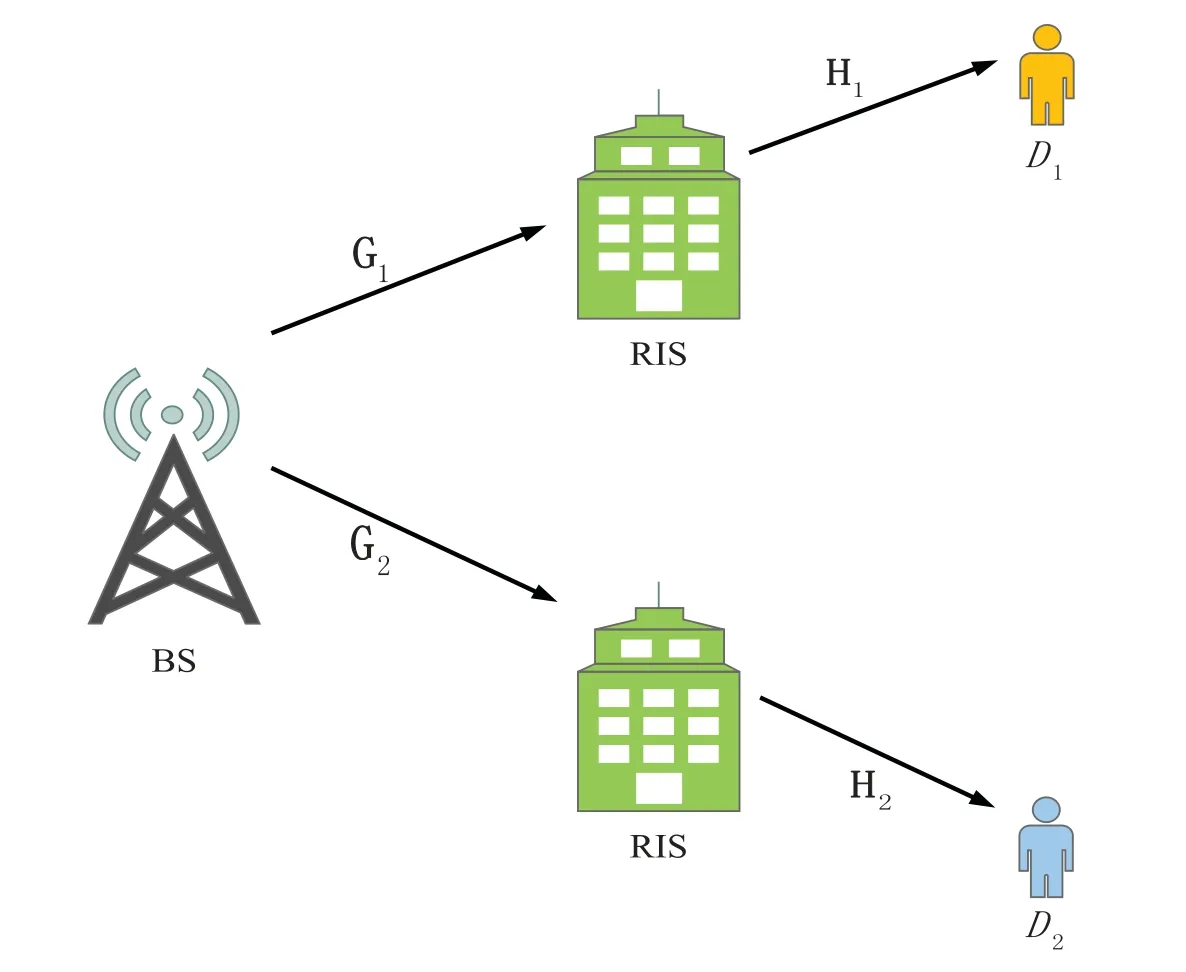
Figure 1:System model of RIS assisted downlink NOMA networks
2.1 Channel Model
It is assumed that the channel state information of all channels is completely known at the BS.The complex channel coefficients from the BS toRnand fromRntoDnare represented by Gn∈CK×1and Hn∈CK×1, respectively.Assume that the wireless links for RIS-NOMA networks are modeled as Rician fading channels.The cascade channel gains from the BS toRnand fromRntoDncan be expressed as HHn ϑnGn.The channel coefficient matrixes can be written as
and
where the channel coefficients from the BS to thek-th reflecting element ofRnand from thek-th reflecting element ofRntoDnare respectively given by
2.2 Signal Model
Based on the superposition coding scheme,the BS broadcasts superposed signaltoD1andD2, wherePbmeans the normalized transmit power of the BS,snrepresents the unit power signal transmitted toDnwithandenoting the power allocation factor ofDn.For simplicity,we assume a fixed power allocation between two users.The optimized power sharing between nonorthogonal users can further enhance the system performance of RIS-NOMA networks,which will be studied in future work.For user fairness,the power allocation factor satisfiesa2>a1witha1+a2=1.The received signals atD1andD2are respectively given by
wherenDnrepresents the additive white Gaussian noise with the mean powerN0atDn.On the basis of the successive interference cancellation(SIC)principle,the signal ofD2is detected first atD1.The received signal-to-interference-plus-noise ratio(SINR)atD1to detect signals2ofD2is given by
The signal ofD2is directly detected by treating the signal ofD1as interference atD2.The received SINR ofD2to detect its own signal can be given by
2.3 RIS-OMA
For comparison, we regard the RIS-OMA scheme as the benchmark, in which the BS sends information to two OMA users through two RISs in two time slots.In each time slot, signalsnis transmitted from the BS toDnby utilizingRn.The observation atDnis given by
The received SINR atDnfor detecting its own signal can be given by
2.4 Channel Statistics
In order to achieve optimal performance,we use the coherent phase shift design.For the wireless communication links of RIS-NOMA networks,our goal is to optimize the channel by adjusting the amplitude and phase of the RIS to achieve the optimal channel gain for each user.For the BS-RIS-Dnlink,we maximize,whereGnkandHnkare thek-th element of Gnand Hn,respectively.In order to achieve maximization,the sum of the phase ofGknHknand the phase shiftθknof thek-th reflecting element of the RIS is equal to zero.Therefore,we have
whereβ=1 without loss of generality.
The channel coefficientsGnkfrom the BS to thek-th reflecting element andHnkfrom thek-th reflecting element toDnfollow Rician distribution,hence the probability density function(PDF)of cascade Rician channelin[31]is expressed as
whereKν(·)denotes the modified Bessel function of the second kind with orderν[32].The mean and variance ofXnkare respectivelywritten as
where·)represents the Laguerre polynomial and
3 Outage Probability
In communication systems,the outage probability can be defined as the probability that the outage occurs for a user when the information rate of the user is lower than its target rate.The outage probability is a widely used system performance metric in fixed-rate transmission systems.In this section,the outage performance of downlink RIS-NOMA networks is investigated.
3.1 Outage Probability of D1
By using the SIC scheme at nearby userD1,the signal of distant userD2is detected first,and then its own signal is detected.Therefore, when both signalss1ands2cannot be successfully detected byD1,an outage occurs forD1.Based on Eqs.(7)and(8),the outage probability ofD1for RIS-NOMA networks can be expressed as
whereγth1= 2r1-1 andγth2= 2r2-1 represent the target SNRs withr1andr2denoting the target rates ofD1andD2to detect signalss1ands2,respectively.The outage probability ofD1is derived in the following theorem.
Theorem 3.1.Under Rician fading channels,the closed-form expression for the outage probability ofD1for RIS-NOMA networks can be approximated as
Proof:See Appendix A.
Remark 3.1.From Eq.(17),it is observed that the approximate outage probability ofD1for RISNOMA is subject toρ,K,κ, andαwhen the target SNR and the power allocation coefficient are fixed.Specifically,increasingρ,K,κ,andα,the approximate outage probability ofD1for RIS-NOMA decreases.As a result,the outage performance ofD1for RIS-NOMA can be enhanced.
3.2 Outage Probability of D2
On account of the NOMA principle,the signal ofD2is directly detected at distant userD2.Thus the outage occurs forD2when signals2cannot be successfully detected byD2.In view of Eq.(9),the outage probability ofD2for RIS-NOMA networks can be expressed as
The outage probability ofD2is derived in the following theorem.
Theorem 3.2.Under Rician fading channels,the closed-form expression for the outage probability ofD2for RIS-NOMA networks can be approximated as
Proof:See Appendix B.
Remark 3.2.From Eq.(19),it can be seen that the approximate outage probability ofD2for RISNOMA depends onρ,K,κ, andα.Similarly, asρ,K,κ, andαincrease, the approximate outage probability ofD2for RIS-NOMA decreases.Consequently, the outage performance ofD2for RISNOMA can be improved.
3.3 Outage Probability of Dn for RIS-OMA
For RIS-OMA networks,Dndetects its own signalsnin each time slot.Hence the outage occurs forDnwhen its own signal cannot be successfully detected.According to Eq.(11),the outage probability ofDnfor RIS-OMA networks can be expressed as
Corollary 3.1.Under Rician fading channels,the closed-form expression for the outage probability ofDnfor RIS-OMA networks can be approximated as
3.4 Diversity Analysis
In communication systems,the diversity order can be defined as the slope of the outage probability at high SNR.The diversity order describes the speed at which the outage probability decreases with the transmit SNR,which is usually used to evaluate the outage performance of wireless communication networks.The diversity order can be expressed as
In order to obtain further insights,the approximate results of the outage probability are analyzed at high SNR,which can be used to determine the diversity order.The asymptotic outage probabilities ofD1andD2at high SNR for RIS-NOMA networks can be provided in the following corollary.
Corollary 3.2.Based on Eqs.(17)and(19),whenρ→∞,the asymptotic expressions for outage probability ofD1andD2for RIS-NOMA networks can be respectively given by
Proof:Applying the series representation [32], whenρ→∞, we haveλ→0 andλ2→0, by extracting the first term(n= 0)of series representation,the high SNR approximate expressions can be given by
Substituting Eqs.(25) and (26) into Eqs.(17) and (19), respectively, Eqs.(23) and (24) can be obtained.The proof is completed.
Remark 3.3.From Eqs.(23)and(24),it can be observed that the asymptotic outage probabilities ofD1andD2for RIS-NOMA are related toρ,K,κ,andα.Hence the asymptotic outage probabilities ofD1andD2for RIS-NOMA increase with the increase ofρ,K,κ,andαat high SNR.
Substituting Eqs.(23)and(24)into Eq.(22),the diversity orders ofD1andD2for RIS-NOMA networks can be respectively calculated as
Remark 3.4.From Eqs.(27) and (28), we can observe that the diversity orders ofD1andD2for RIS-NOMA are influenced by the number of reflecting elements of RIS, the Rician factor, and the path loss exponent.
Remark 3.5.It can be observed that the diversity orders increase asK,κ, andαincrease.The outage probability curve becomes steeper with the increase of the diversity order,resulting in the faster convergence of the outage probability.Therefore,increasing the diversity order can improve the outage performance of RIS-NOMA at high SNR.
Remark 3.6.Similarly,the diversity order ofDnfor RIS-OMA is,which is also in connection withK,κ,andα.
3.5 Delay-Limited System Throughput
The system throughput is an important performance metric in wireless communication systems.The research on system throughput is of great significance for practical implementation.In the delaylimited transmission mode, the information is transmitted from the BS to users at a constant rate,which leads to outage due to the influence of the wireless fading channels.Therefore, the system throughput depends on the outage probability in the delay-limited transmission mode.The delaylimited system throughput of RIS-NOMA is expressed as
wherePD1andPD2are the outage probabilities from Eqs.(17)and(19),respectively.
4 Ergodic Rate
The ergodic rate is a commonly used system performance metric in adaptive-rate transmission systems.In this section,the ergodic rates of two users for RIS-NOMA networks are analyzed.
4.1 Ergodic Rate of D1
Based on SIC principle, ifD1can successfully detect the signal ofD2, the achievable rate ofD1can be given byOn account of Eq.(8),the ergodic rate ofD1for RIS-NOMA networks is expressed as
The ergodic rate ofD1is obtained in the following theorem.
Theorem 4.1.Under Rician fading channels, the exact expression for the ergodic rate ofD1for RIS-NOMA is calculated as
Proof:See Appendix C.
Remark 4.1.From Eq.(31), we can observe that the ergodic rate ofD1for RIS-NOMA is dependent onρ,K,κ,andαwhen the target SNR and the power allocation coefficient are constants.More specifically,with the increase ofρ,K,κ,andα,the ergodic rate ofD1for RIS-NOMA increases.
4.2 Ergodic Rate of D2
Assuming thatD2can detect its own signals2, the achievable rate ofD2can be given byRD2=In virtue of Eq.(9),the ergodic rate ofD2for RIS-NOMA networks is expressed as
The ergodic rate ofD2is obtained in the following theorem.
Theorem 4.2.Under Rician fading channels,the approximate expression for the ergodic rate ofD2for RIS-NOMA is calculated as
Proof:See Appendix D.
Remark 4.2.From Eq.(33),it is observed that the ergodic rate ofD2for RIS-NOMA is related toρ,K,κ,andα.Similarly,the ergodic rate ofD2for RIS-NOMA increases withρ,K,κ,andα.
4.3 Ergodic Rate of Dn for RIS-OMA
For RIS-OMA networks, sinceDncan detect its own signalsn, the achievable rate ofDncan be given byAccording to Eq.(11), the ergodic rate ofDnfor RIS-OMA networks can be expressed as
Similar to the derivation process of Eq.(31), the ergodic rate ofDncan be presented in the following corollary.
Corollary 4.1.Under Rician fading channels,the exact expression for the ergodic rate ofDnfor RIS-OMA is given by
4.4 Slope Analysis
Similar to the diversity order,the high SNR slope can be defined as the slope of the ergodic rate at high SNR,which describes how fast the ergodic rate increases with the transmit SNR.The high SNR slope can be expressed as
To gain deep insights into the system performance,the approximate ergodic rate at high SNR is studied,which can be used to calculate the high SNR slope.However,the approximate ergodic rate ofD1at high SNR cannot be obtained from Eq.(31).For the convenience of analyses,the upper bound for the ergodic rate ofD1can be derived in the following theorem.
Theorem 4.3.Under Rician fading channels,the upper bound for the ergodic rate ofD1for RISNOMA can be calculated as
Proof:Based on Eq.(30), by adopting the Jensen’s inequality, the upper bound for the ergodic rate ofD1can be given by
On the basis of Eq.(12),the upper bound for the ergodic rate ofD1can be expressed as
According to Eqs.(14)and(15),the upper bound for the ergodic rate ofD1can be calculated as
Hence Eq.(37)can be obtained.The proof is completed.
Remark 4.3.From Eq.(37), we can observe that the upper bound for the ergodic rate ofD1for RIS-NOMA is related toρ,K,κ,andα.Specifically,the upper bound for the ergodic rate ofD1for RIS-NOMA increases withρ,K,κ,andα.
The asymptotic upper bound for the ergodic rate ofD1at high SNR for RIS-NOMA networks can be provided in the following corollary.
Corollary 4.2.Based on Eq.(37),whenρ→∞,the asymptotic upper bound for the ergodic rate ofD1for RIS-NOMA can be given by
Remark 4.4.From Eq.(41),we can observe that the asymptotic upper bound for the ergodic rate ofD1for RIS-NOMA depends onρ,K,κ,andα.Similarly,increasingρ,K,κ,andα,the asymptotic upper bound for the ergodic rate ofD1for RIS-NOMA increases at high SNR.
Substituting Eq.(41) into Eq.(36), the high SNR slope ofD1for RIS-NOMA networks can be calculated as
Remark 4.5.From Eq.(42), we can observe that the high SNR slope ofD1for RIS-NOMA is a non-zero value.This implies that the ergodic rate ofD1for RIS-NOMA tends to infinity at high SNR.The higher the high SNR slope, the steeper the ergodic rate curve, which results in the faster convergence of the ergodic rate.Hence the ergodic rate increases with the increase of the high SNR slope.
The asymptotic ergodic rate ofD2at high SNR for RIS-NOMA networks can be presented in the following corollary.
Corollary 4.3.Based on Eq.(32),whenρ→∞,the asymptotic ergodic rate ofD2for RIS-NOMA can be calculated as
Proof:With the aid of Eqs.(9)and(12),we can obtain
In view of Eq.(32),whenρ→∞,the asymptotic ergodic rate ofD2can be calculated as
Hence Eq.(43)can be obtained.The proof is completed.
Remark 4.6.From Eq.(43), it can be observed that the asymptotic ergodic rate ofD2for RISNOMA is a constant when the power allocation coefficient is fixed.Hence the asymptotic ergodic rate ofD2for RIS-NOMA remains unchanged at high SNR.
Substituting Eq.(43) into Eq.(36), the high SNR slope ofD2for RIS-NOMA networks can be calculated as
Remark 4.7.From Eq.(46),it can be observed that the high SNR slope ofD2for RIS-NOMA is zero.This means that the ergodic rate ofD2for RIS-NOMA is a constant.Hence the ergodic rate ofD2for RIS-NOMA converges to a throughput ceiling at high SNR.
Similar to the derivation process of Eq.(37),the upper bound for the ergodic rate ofDnfor RISOMA networks can be obtained in the following corollary.
Corollary 4.4.Under Rician fading channels,the upper bound for the ergodic rate ofDnfor RISOMA is given by
The asymptotic upper bound for the ergodic rate ofDnat high SNR for RIS-OMA networks can be provided in the following corollary.
Corollary 4.5.Based on Eq.(47),whenρ→∞,the asymptotic upper bound for the ergodic rate ofDnfor RIS-OMA can be given by
Remark 4.8.Substituting Eq.(48)into Eq.(36),the high SNR slope ofDnfor RIS-OMA networks is equal to
4.5 Delay-Tolerant System Throughput
In the delay-tolerant transmission mode,the information is transmitted from the BS to users at any constant rate, which is subject to the channel conditions of the users.Hence the delay-tolerant system throughput of RIS-NOMA is expressed as
whereandare t he ergodic rates from Eqs.(31)and(33),respectively.
5 Numerical Results
In this section, numerical results are presented to evaluate the performance of RIS-NOMA networks over Rician fading channels.The effects of the Rician factor, the number of reflecting elements of the RIS, and the pass loss exponent on the performance of RIS-NOMA networks are discussed.The accuracy of the derived theoretical results can be verified by Monte Carlo simulations.In order to compare the performance with the RIS-NOMA networks, the conventional RIS-OMA networks are also provided.Without loss of generality,the power allocation factors of two users are set toa1= 0.2 anda2= 0.8,the target rates of two users are set tor1= 0.0005 bits per channel use(BPCU)andr2=0.002 BPCU.In order to simplify the calculation,we adopt the normalized distance for dimensionless physical quantity.It is assumed that the distances from the BS toR2and fromR2toD2are normalized to unity.The normalized distances from BS toR1andR2,fromR1toD1,and fromR2toD2are set tod1,1= 0.4,d2,1= 0.5,d1,2= 0.4,andd2,2= 0.5,respectively.For clarity,the main parameters used for numerical results are summarized in Table 1.

Table 1: The parameters for numerical results
5.1 Outage Probability
Fig.2 plots the outage probabilities of two usersvs.the transmit SNR for RIS-NOMA networks.The parameters are set toK= 8,κ= -10 dB, andα= 2.We can observe that the accurate outage probability curves given by Monte Carlo simulations are in good agreement with the derived theoretical outage probability results for RIS-NOMA networks, which verifies the accuracy of the derived theoretical outage probability results.It can be observed that the outage performance of RIS-NOMA networks is better than that of RIS-OMA networks.The reason is that RIS-NOMA can provide services for multiple users in the same time slot by adopting the superposition coding scheme, while RIS-OMA can only provide services for one user in each time slot.One can observe that the asymptotic outage probability curves converge to the derived theoretical results in the high SNR regime,which also demonstrates the accuracy of the theoretical analysis.As can be observed that the outage probability decreases with the increase of the transmit SNR.One can make the following observation from figure that the outage probabilities of two users converge to zeros in the high SNR regime and thus the non-zero diversity order can be obtained.
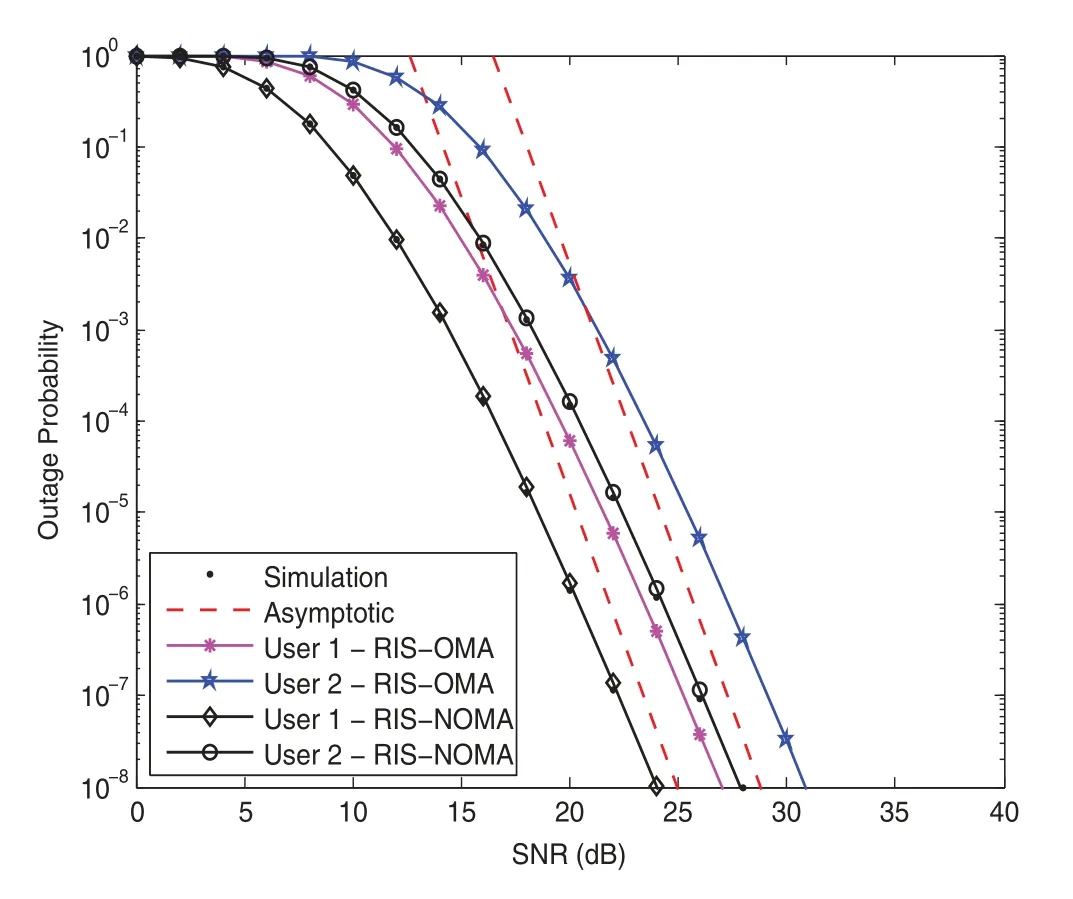
Figure 2:Outage probability vs.the transmit SNR when K=8,κ =-10 dB,and α=2
Fig.3 plots the outage probabilities of two usersvs.the transmit SNR with differentKfor RISNOMA networks.The parameters are set toκ= -10 dB andα= 2.It is observed that the outage probabilities of two users for RIS-NOMA decrease with increasing the number of reflecting elementsK, thus the outage performance for RIS-NOMA can be improved.The reason is that the diversity orders of two users for RIS-NOMA depend on the number of reflecting elements.

Figure 3:Outage probability vs.the transmit SNR with different K when κ =-10 dB and α=2
In order to explain the influence of the Rician factor on the outage performance of RIS-NOMA networks,Fig.4 plots the outage probabilities of two usersvs.the transmit SNR with differentκfor RIS-NOMA networks.The parameters are set toK= 8 andα= 2.As can be seen from the figure that as the value of the Rician factorκincreases,the outage probabilities of two users for RIS-NOMA reduce, hence the outage performance of RIS-NOMA becomes better.This is due to the fact that the diversity orders of two users for RIS-NOMA are related to the value of the Rician factor.The reason behind this phenomenon is that there are a large number of LoS components of Rician fading channels,which greatly improves the outage performance of RIS-NOMA networks.

Figure 4:Outage probability vs.the transmit SNR with different κ when K=8 and α=2
To further illustrate the impact of the path loss exponent on the outage performance of RISNOMA networks,Fig.5 plots the outage probabilities of two usersvs.the transmit SNR with differentαfor RIS-NOMA networks.The parameters are set toK= 8 andκ= -10 dB.It can be seen that the outage probabilities of two users for RIS-NOMA increase significantly with the decrease of the path loss exponentα,therefore the outage performance for RIS-NOMA deteriorates sharply.This is because that the path loss exponent reflects the number of obstacles in the propagation environment.

Figure 5:Outage probability vs.the transmit SNR with different α when K=8 and κ =-10 dB
5.2 Ergodic Rate
Fig.6 plots the ergodic rates of two usersvs.the transmit SNR for RIS-NOMA networks.The parameters are set toK= 20,κ= -10 dB,andα= 2.We can see from the figure that the Monte Carlo simulation ergodic rate curves are completely consistent with the derived theoretical ergodic rate results for RIS-NOMA,which demonstrates the accuracy of the derived theoretical ergodic rate results.Another observation is that the upper bound curve for ergodic rate ofD1is very close to the derived theoretical ergodic rate.As can be observed from this figure that the ergodic rate ofD2converges to a throughput ceiling at high SNR and therefore leads to a zero high SNR slope.The important observation is that the ergodic rate ofD1for RIS-NOMA is higher than that ofD1for RISOMA at high SNR.The reason is that the high SNR slope ofD1for RIS-NOMA exceeds that ofD1for RIS-OMA.On the other hand,the ergodic rate ofD2for RIS-NOMA is lower than that ofD2for RIS-OMA at high SNR.This is because thatD2for RIS-NOMA has a smaller the high SNR slope compared withD2for RIS-OMA.
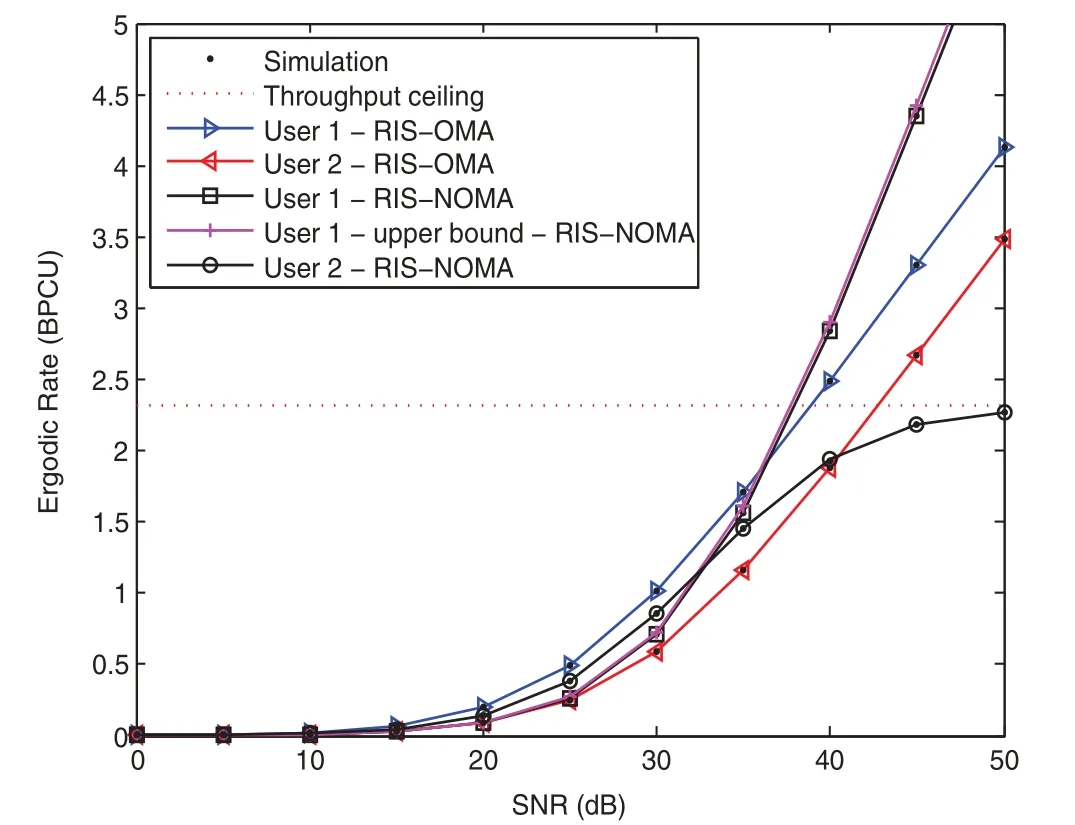
Figure 6:Ergodic rate vs.the transmit SNR when K=20,κ =-10 dB,and α=2
Considering the influence of the number of reflecting elements on the ergodic performance of RIS-NOMA networks,Fig.7 plots the ergodic rates of two usersvs.the transmit SNR with differentKfor RIS-NOMA networks.The parameters are set toκ=-10 dB andα=2.We can observe from the figure that the ergodic rates of two users for RIS-NOMA increase as the number of reflecting elementsKincreases.Another observation is that the ergodic rate ofD1is extremely large with respect to that ofD2for RIS-NOMA with the increase of the number of reflecting elements.This is due to the fact that there is a throughput ceiling at high SNR for the ergodic rate ofD2for RIS-NOMA.
5.3 System Throughput
Fig.8 plots the system throughputvs.the transmit SNR with differentKfor RIS-NOMA networks in delay-limited transmission mode.The parameters are set toκ= -10 dB andα= 2.It can be seen that RIS-NOMA is capable of enhancing the system throughput compared to RISOMA.The reason is that the system throughput depends on the outage probability in delay-limited transmission mode.One can make the following observation from figure that the system throughput of RIS-NOMA converges to a constant at high SNR.This phenomenon indicates that the system throughput no longer increases with the increase of SNR when it reaches a fixed value at high SNR.Another observation is that as the number of reflecting elements increases,the system throughput of RIS-NOMA can be significantly improved.
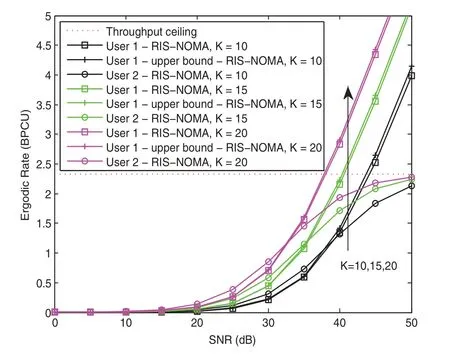
Figure 7:Ergodic rate vs.the transmit SNR with different K when κ =-10 dB and α=2
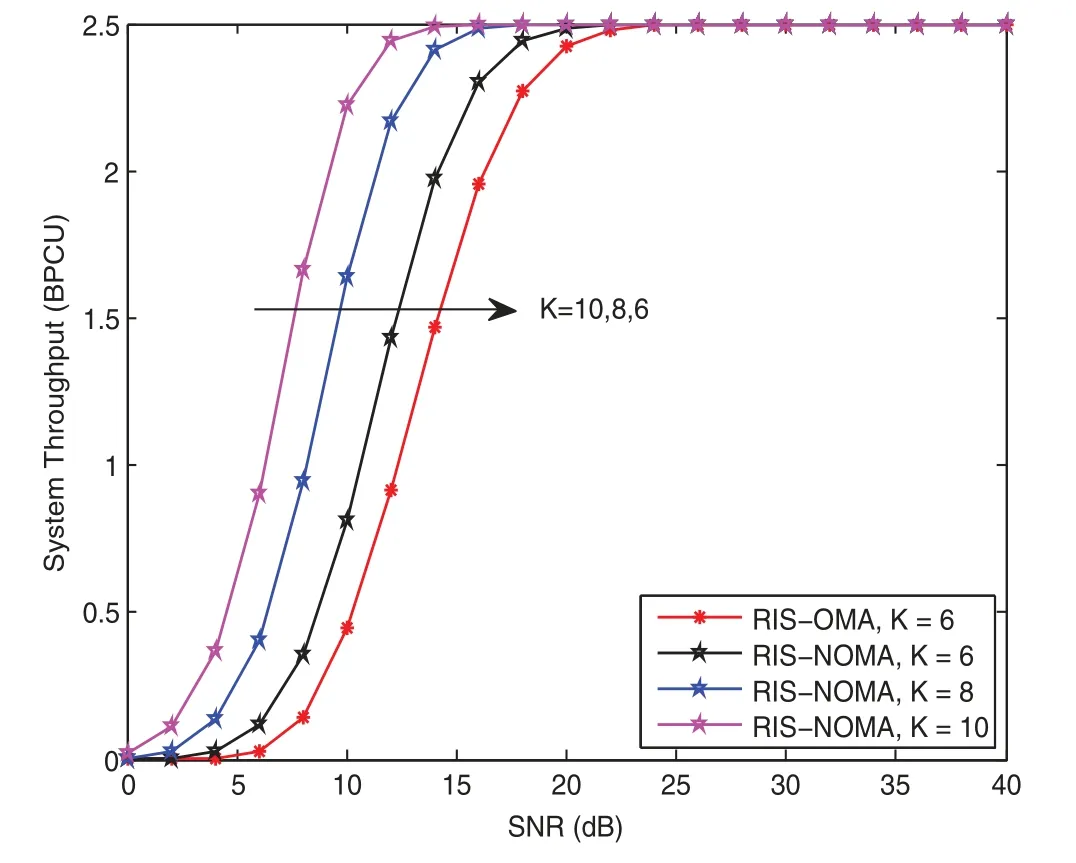
Figure 8:System throughput in delay-limited transmission mode vs.the transmit SNR with different K when κ =-10 dB and α=2
As a further advance, Fig.9 plots the system throughputvs.the transmit SNR with differentKfor RIS-NOMA networks in delay-tolerant transmission mode.The parameters are set toκ=-10 dB andα=2.It can be observed that RIS-NOMA can achieve a larger system throughput than RIS-OMA at high SNR.The main reason behind this is that the system throughput is related to the ergodic rate in delay-tolerant transmission mode.It is observed from the figure that the system throughput of RIS-NOMA becomes larger with increasing the number of reflecting elements.
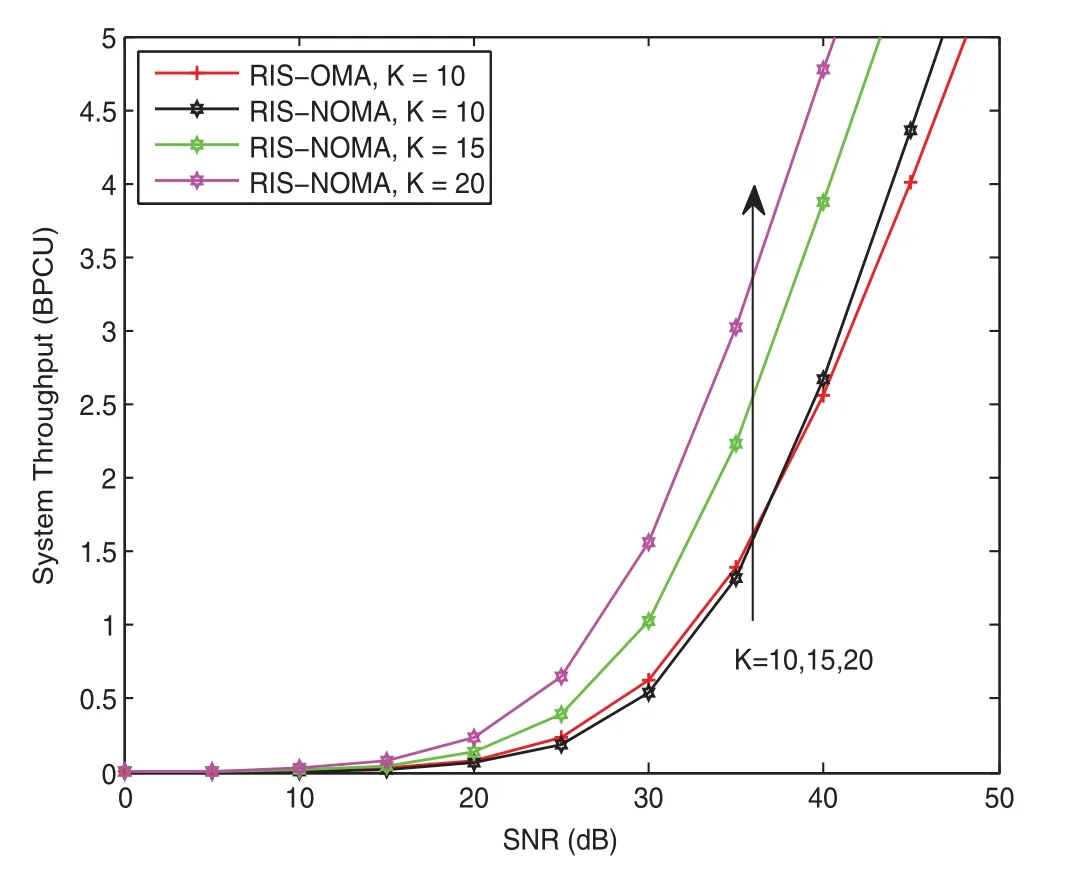
Figure 9:System throughput in delay-tolerant transmission mode vs.the transmit SNR with different K when κ =-10 dB and α=2
6 Conclusion
In this paper,the system performance of RIS-assisted downlink NOMA communication networks has been investigated in terms of the outage probability, ergodic rate, and system throughput over Rician fading channels.The exact and asymptotic expressions for the outage probability and ergodic rate of two users for RIS-NOMA networks have been derived.Based on the theoretical analyses,the diversity orders and high SNR slopes of the two users have been obtained at high SNR.In addition, the system throughputs of RIS-NOMA networks have been derived in delay-limited and delay-tolerant transmission modes.Simulation results have indicated that the outage probability and ergodic rate of RIS-NOMA outperform that of RIS-OMA.It has been shown that the system throughput of RIS-NOMA is superior to that of RIS-OMA.Moreover, it has been demonstrated that the system performance of RIS-NOMA networks becomes better with increasing the number of reflecting elements and Rician factor.Based on this work,we will consider extending the research to multiple users in the future.In addition,optimized power allocation and multiple antennas of device nodes are also promising research directions.
Funding Statement:This work was supported in part by the Key R&D Program of Zhejiang Province under Grant No.2020C05005, in part by the National Natural Science Foundation of China under Grants U2033215, 91738301, 91538202, and 91638301, in part by the Program for New Century Excellent Talents in University under Grant NCET-09-0025,and in part by the Fundamental Research Funds for the Central Universities.The work of C.Huang was partially supported by the China National Key R&D Program under Grant 2021YFA1000500,National Natural Science Foundation of China under Grant 62101492, Zhejiang Provincial Natural Science Foundation of China under Grant LR22F010002, Distinguished Young Scholars of the National Natural Science Foundation of China, Ng Teng Fong Charitable Foundation in the form of ZJU-SUTD IDEA Grant, Zhejiang University Education Foundation Qizhen Scholar Foundation, and Fundamental Research Funds for the Central Universities under Grant 2021FZZX001-21.The work of X.Yue was supported by the National Natural Science Foundation of China under Grant 62071052 and the R&D Program of Beijing Municipal Education Commission under Grant KM202011232003.
Conflicts of Interest:The authors declare that they have no conflicts of interest to report regarding the present study.
Appendix A:Proof of Theorem 1
Substituting Eqs.(7) and (8) into Eq.(16), based on Eq.(12), the outage probability ofD1for RIS-NOMA networks is expressed as
whereλ≜max(λ1,λ2),witha2>a1γth2.
Applying the series of Laguerre polynomials[33],the PDF ofis approximated as
Substituting Eq.(A.2)into Eq.(A.1),the outage probability ofD1can be approximated as
Applying the lower incomplete Gamma function [32], the outage probability ofD1can be calculated as
Appendix B:Proof of Theorem 2
Substituting Eq.(9)into Eq.(18),the outage probability ofD2for RIS-NOMA networks can be expressed as
where the last equality holds because of Eq.(12).
Substituting Eq.(B.2)into Eq.(B.1),using,the outage probability ofD2can be approximated as
By referring to the lower incomplete Gamma function, the outage probability ofD2can be calculated as
Appendix C:Proof of Theorem 3
Substituting Eq.(8)into Eq.(30),according to Eq.(12),the ergodic rate ofD1for RIS-NOMA networks can be expressed as
The CDF ofY1can be written as
Based on Eq.(17),the CDF ofY1is given by
Substituting Eq.(C.3)into Eq.(C.1),the ergodic rate ofD1can be approximated as
Hence Eq.(31)can be obtained.The proof is completed.
Appendix D:Proof of Theorem 4
Substituting Eq.(9) into Eq.(32), in view of Eq.(12), the ergodic rate ofD2for RIS-NOMA networks can be expressed as
The CDF ofY2can be written as
wherea2>a1y.According to Eq.(19),the CDF ofY2can be given by
Substituting Eq.(D.3)into Eq.(D.1),the ergodic rate ofD2can be approximated as
Applying Chebyshev-Gauss quadrature[34],the ergodic rate ofD2can be calculated as
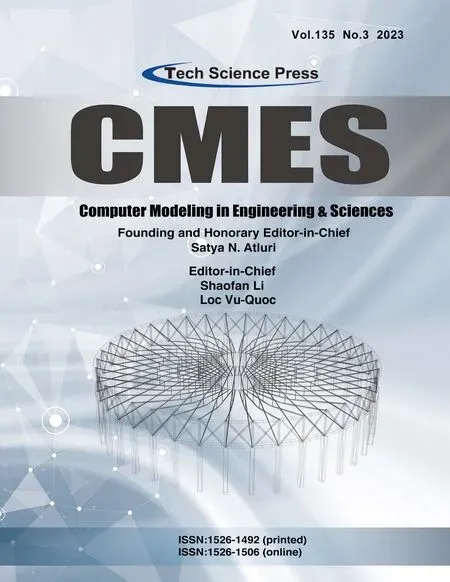 Computer Modeling In Engineering&Sciences2023年6期
Computer Modeling In Engineering&Sciences2023年6期
- Computer Modeling In Engineering&Sciences的其它文章
- Finite Element Implementation of the Exponential Drucker-Prager Plasticity Model for Adhesive Joints
- A Review of Electromagnetic Energy Regenerative Suspension System&Key Technologies
- Arabic Optical Character Recognition:A Review
- Survey on Task Scheduling Optimization Strategy under Multi-Cloud Environment
- A Review of Device-Free Indoor Positioning for Home-Based Care of the Aged:Techniques and Technologies
- Topology Optimization for Harmonic Excitation Structures with Minimum Length Scale Control Using the Discrete Variable Method
